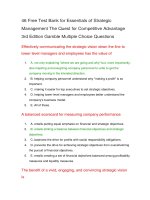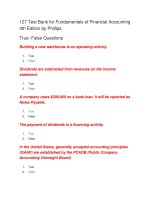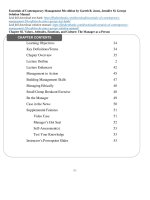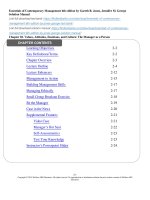Test bank for essentials of contemporary management 4th edition by jones
Bạn đang xem bản rút gọn của tài liệu. Xem và tải ngay bản đầy đủ của tài liệu tại đây (203.78 KB, 60 trang )
Full file at />
Chapter 01
The Management Process Today
True / False Questions
1. A desired future outcome that a firm hopes to achieve is called a goal.
True False
2. The planning, organizing, leading, and controlling of resources in order to achieve
organizational goals both effectively and efficiently is known as management.
True False
3. An organization's people are not considered one of its resources as they are not permanent.
True False
4. Management is the process of planning, organizing, leading and controlling resources in
order to make a profit. Therefore, an administrator of a not-for-profit organization is not truly
a manager.
True False
5. Increase in a firm's effectiveness will increase its performance, but increase in efficiency
will have no predictable effect on performance.
True False
6. McDonald's developed a fat fryer that decreases the amount of oil used in cooking, and
reduced the amount of time to cook fries. This is an example of increased efficiency.
True False
7. Effectiveness is a measure of how productively a firm uses its resources to achieve a goal.
True False
buy this full document at
Full file at />
8. In general, jobs become more interesting the more complex or responsible they are.
True False
9. Effective managers are those who choose the right organizational goals to pursue and have
the skills to utilize resources efficiently.
True False
10. A measure of the appropriateness of goals selected by managers for the organization and
the degree to which the organization achieves these goals is known as the effectiveness of the
organization.
True False
11. The process that managers use to select the goals for the organization is known as
organizing.
True False
12. An organization's strategy is an outcome of its planning process.
True False
13. Grouping people into various departments of a firm is known as organizing.
True False
14. An organization's structure determines how the organization's resources can be used to
create goods and services.
True False
15. The outcome of the controlling function should be the ability to measure the organization's
performance accurately.
True False
buy this full document at
Full file at />
16. Considering the management hierarchy, first-line managers typically report to top
managers.
True False
17. To perform managerial tasks efficiently and effectively, organizations group their
managers by level in hierarchy and by type of skill.
True False
18. Managers who supervise first-line managers are typically called middle managers.
True False
19. The relative importance of planning, organizing, leading, and controlling differ depending
on the level of management that a manager occupies.
True False
20. The lower the manager's position in the organization's hierarchy, the less time the manager
will spend leading and controlling subordinates.
True False
21. The amount of time that managers spend planning and organizing resources decreases as
they move towards higher levels in the organization.
True False
22. The lower the managers' positions are in the hierarchy, the more time the managers spend
leading and controlling first-line managers or nonmanagerial employees.
True False
23. On a relative scale, managers spend a considerable amount of time on controlling.
True False
buy this full document at
Full file at />
24. The ability to distinguish between the cause and effect of a problem within an
organization is an important part of the conceptual skills of a manager.
True False
25. An organization's top managers need to have more conceptual skills than other managers.
True False
26. Human skills can be learned through education and training, but they cannot be developed
through work experience.
True False
27. Thorough and direct feedback allows managers to develop their human skills.
True False
28. The array of technical skills managers need depends on their position in their
organizations.
True False
29. Departmental skills that create a core competency give an organization a competitive
advantage.
True False
30. The dramatic change in the tasks and responsibilities of managers can be predominantly
attributed to global competition and advances in new information technology (IT).
True False
31. Modern information technology has contributed to increases in restructuring and
outsourcing in organizations.
True False
buy this full document at
Full file at />
32. Self-managed teams and empowerment are ways to increase efficiency and effectiveness
in an organization.
True False
33. In a self-managed team, first-line managers act as coaches or mentors to provide advice
and guidance and help teams find new ways to perform their tasks more efficiently.
True False
34. Information technology facilitates the use of self-managed teams.
True False
35. Responsiveness to customers is one of the building blocks of competitive advantage.
True False
36. Companies that have speed and flexibility are agile competitors.
True False
37. Pressure to increase performance can be healthy for an organization because it leads
managers to question the way the organization is working.
True False
38. Crisis management involves making important choices about how to establish the
organizational chain of command and reporting relationships necessary to mobilize a fast
response.
True False
39. The causes of global crises or disasters fall into three main categories: natural causes,
human causes, and international terrorism and geopolitical conflicts.
True False
buy this full document at
Full file at />
Multiple Choice Questions
40. The measure of how well (or how productively) an organization uses its resources to
achieve a goal is known as:
A. effectiveness.
B. appropriateness.
C. efficiency.
D. timeliness.
E. appraisal.
41. Burger King developed a fat-fryer machine that reduced the amount of oil used to fry
burgers by 30 percent over its current competitors. This is an example of an attempt to
improve the organization's:
A. effectiveness.
B. efficiency.
C. planning.
D. organizing.
E. appropriateness.
42. A manager who chooses inappropriate goals for the organization, but makes good use of
the organization's resources in pursuing these goals is said to have:
A. low effectiveness/medium efficiency.
B. low effectiveness/high efficiency.
C. medium effectiveness/low efficiency.
D. high effectiveness/high efficiency.
E. medium effectiveness/medium efficiency.
43. A manager who chooses the wrong goals for the organization and makes poor use of the
organization's resources in pursuing these goals is said to have:
A. low effectiveness/low efficiency.
B. low effectiveness/medium efficiency.
C. medium effectiveness/low efficiency.
D. high effectiveness/high efficiency.
E. medium effectiveness/medium efficiency.
buy this full document at
Full file at />
44. When a manager produces a new product that many customers want to purchase and sells
it at a price that is attractive to these customers, this manager is said to have:
A. medium efficiency/low effectiveness.
B. low efficiency/high effectiveness.
C. high efficiency/high effectiveness.
D. low efficiency/medium effectiveness.
E. medium effectiveness/medium efficiency.
45. When a manager produces a product that customers want, but that is too expensive for
them to buy, the manager is said to have:
A. low efficiency/low effectiveness.
B. low efficiency/high effectiveness.
C. high efficiency/high effectiveness.
D. low efficiency/medium effectiveness.
E. medium effectiveness/medium efficiency.
46. The measure of the "appropriateness" of the goals selected by management for the
organization and the degree to which the organization accomplishes these goals is known as:
A. efficiency.
B. strategy.
C. effectiveness.
D. conceptual skill.
E. restructuring.
47. The people within an organization who are responsible for supervising the organization's
use of its resources are known as:
A. managers.
B. normalisers.
C. precisionist.
D. strategists.
E. restructurers.
buy this full document at
Full file at />
48. All of the following are essential managerial functions EXCEPT:
A. leading.
B. controlling.
C. demonstrating.
D. planning.
E. organizing.
49. In what order do managers typically perform managerial functions?
A. Organizing, Planning, Controlling, Leading
B. Organizing, Leading, Planning, Controlling
C. Planning, Organizing, Leading, Controlling
D. Planning, Organizing, Controlling, Leading
E. Leading, Organizing, Planning, Controlling
50. Planning involves:
A. measuring and monitoring organizational goals.
B. evaluating how well the organization has achieved its goals.
C. energizing individuals and groups to work together to achieve organizational goals.
D. deciding the strategies to adopt to attain organizational goals.
E. allowing people to work together to achieve organization goals.
51. The outcome of planning is _____, a cluster of decisions concerning what organizational
goals to pursue, what actions to take, and how to use resources to achieve goals.
A. turnaround
B. control mechanism
C. strategy
D. restructuring
E. empowerment
buy this full document at
Full file at />
52. The process that managers use to design a structure of working relationships that allows
employees to work together to achieve organizational goals is called:
A. planning.
B. leading.
C. demonstrating.
D. controlling.
E. organizing.
53. When a manager groups workers into departments based on the tasks that they perform, it
is called:
A. planning.
B. organizing.
C. leading.
D. demonstrating.
E. controlling.
54. A formal system of reporting relationships that coordinates workers so that they work
together to attempt to achieve organizational goals is called a(n):
A. leading strategy.
B. controlling strategy.
C. organizational structure.
D. low-cost strategy.
E. efficiency strategy.
55. Mr. Jake, CEO of Star, Inc. draws a picture of the reporting relationships that will occur
under the new management reorganization. This is an example of:
A. planning.
B. leading.
C. organizing.
D. executing.
E. controlling.
buy this full document at
Full file at />
56. Effective leadership depends on the use of:
A. power and influence.
B. authority and giving orders.
C. physical resources.
D. structure.
E. policies and procedures.
57. Managers motivating and assisting workers to achieve organizational goals is an important
aspect of:
A. planning.
B. leading.
C. demonstrating.
D. controlling.
E. organizing.
58. Jane, who heads the Finance team, monitors the work performance of her team members
to determine if the quality of their work is "up to standard." Jane is engaging in which
function?
A. Planning
B. Demonstrating
C. Organizing
D. Leading
E. Controlling
59. _____ managers are often called supervisors.
A. First-line
B. Middle
C. Top
D. Interim
E. Consultant
buy this full document at
Full file at />
60. Which of the following is least likely to be a first-line manager?
A. A foreman in an auto assembly plant.
B. The manager of tellers in a bank.
C. The head of a marketing department.
D. A head mechanic in a car dealer's service department.
E. The head nurse in the obstetrics department of a hospital.
61. Who is responsible for finding the best way to organize human and other resources to
achieve organizational goals?
A. First-line manager
B. Middle manager
C. Top manager
D. Executive
E. Supervisor
62. Which of the following is NOT a part of the job of a middle manager?
A. Deciding how to organize human resources
B. Suggesting to top management ways in which goals should be changed
C. Developing and fine-tuning skills and know-how within functional areas
D. Making decisions about the production of goods/services
E. Cross-departmental responsibility
63. When we say that the top managers of an organization are responsible for the performance
of all the departments in an organization, this is another way of saying that they have:
A. restructuring responsibilities.
B. technical responsibilities.
C. global responsibilities.
D. cross-departmental responsibilities.
E. competitive responsibilities.
buy this full document at
Full file at />
64. The top managers of an organization devote most of their time to _____ than lower level
managers do.
A. planning and organizing
B. leading and controlling
C. controlling and staffing
D. staffing and organizing
E. motivation and controlling
65. The ability to analyze and diagnose a problem situation and distinguish between cause and
effect is a:
A. human skill.
B. negotiating skill.
C. technical skill.
D. conceptual skill.
E. service skill.
66. Which of the following includes the ability to understand, lead, and control the behavior
of other workers?
A. Conceptual skill
B. Human skill
C. Technical skill
D. Negotiating skill
E. Organizing skill
67. The ability of a worker in the accounting department to prepare the organization's balance
sheet is an example of a(n):
A. conceptual skill.
B. first-line skill.
C. human skill.
D. technical skill.
E. cognitive skill.
buy this full document at
Full file at />
68. Which of the following is NOT a reason that organizations often group people of similar
technical skills together?
A. They can learn from each other.
B. It is easier to supervise them.
C. It is easer to focus on the bigger picture to identify cause effect relationship.
D. It is easier to train the employees.
E. The employees can easily become more skilled.
69. The specific set of departmental skills, knowledge, and experience that allows one
organization to outperform its competitors is called:
A. total quality management
B. core competencies
C. managerial skill
D. competitive advantage
E. empowerment
70. TeleTop Corporation is planning to eliminate a few redundant departments and reduce
levels in the organizational hierarchy to lower operating costs. This is an example of:
A. empowerment
B. restructuring
C. outsourcing
D. controlling
E. CRM
71. _____ involves simplifying, shrinking, or downsizing an organization's operations to
lower operating costs.
A. Streamlining
B. Reengineering
C. Optimization
D. Restructuring
E. Reforming
buy this full document at
Full file at />
72. Which of the following statements is true regarding restructuring?
A. It is significantly different from downsizing.
B. It focuses on reducing the number of jobs among first-line managers.
C. It can be done by eliminating departments and reducing levels in the hierarchy.
D. Restructuring has decreased in recent years on account of modern IT.
E. Restructuring reduces efficiency and effectiveness.
73. Which of the following statements is true regarding outsourcing?
A. It reduces efficiency.
B. It leads to an increase in operating costs.
C. It is not widely practiced in the business world.
D. It can be used for activities such as manufacturing, marketing, and customer service.
E. It takes up money and resources that could be used in more effective ways.
74. _____ involves contracting with another company, usually in a low-cost country abroad,
to have it perform a work activity the organization previously performed itself.
A. Leasing
B. Sub-letting
C. Importing
D. Exporting
E. Outsourcing
75. The process of expanding employees' knowledge, tasks, and responsibility is called:
A. empowerment
B. restructuring
C. outsourcing
D. controlling
E. job remodeling
buy this full document at
Full file at />
76. _____ involves giving employees more authority and responsibility over the way they
perform their work activities.
A. Empowerment
B. Job remodeling
C. Task analysis
D. Work liberation
E. Emancipation
77. A _____ refers to a group of employees who assume collective responsibility for
organizing, controlling, and supervising their own work activities.
A. quality circle
B. self-managed team
C. cross-functional team
D. project team
E. virtual team
78. All of the following statements are true regarding the role of IT in empowering
employees, EXCEPT:
A. it expands employees' job knowledge.
B. it reduces the scope of employees' job responsibilities.
C. it allows one employee to perform a task that was previously performed by many
employees.
D. it increases an employee's autonomy and responsibility.
E. it facilitates the use of self-managed teams.
79. The use of information technology in self-managed teams:
A. provides team members with real-time information about each others' performance.
B. causes poor resource allocation decisions.
C. results in the underutilization of a firm's human resources.
D. allows first line managers to tell employees how to do their jobs.
E. increases the amount of time required to complete a task.
buy this full document at
Full file at />
80. When CostCo builds a distribution warehouse so that it can supply products to its stores
within a 200-mile radius on almost a daily basis, we say that CostCo has achieved:
A. empowerment.
B. a competitive advantage.
C. increased quality.
D. increased innovation.
E. work liberation.
81. Which of the following is NOT a building block of competitive advantage?
A. Efficiency
B. Innovation
C. Responsiveness to customers
D. Quality
E. Extremity
82. When workers are organized into quality control teams and are given the responsibility of
continuously improving their performance, they are involved in:
A. MBO.
B. SEC.
C. EPA.
D. TQM.
E. NVE
83. The process of creating new products that customers want is called:
A. customer responsiveness.
B. TQM.
C. strategy formulation.
D. innovation.
E. restructuring.
buy this full document at
Full file at />
84. All the following are true about turnaround management EXCEPT:
A. it is the creation of a new vision for a struggling company using a new approach to
planning and organizing.
B. it involves developing radical new strategies
C. it is a complex management task.
D. it is done under conditions of certainty.
E. it is intended to help a company survive, and eventually prosper.
85. When considering the challenges of managing diversity in the workplace, managers
should establish practices that ensure that human resources are treated fairly. Which of the
following is NOT one of the types of diversity managers need to be concerned about for legal
and ethical reasons?
A. Sexual preference
B. Personality
C. Religion
D. Age
E. Gender
86. Crisis management involves all of the following EXCEPT:
A. creating teams to facilitate rapid communication.
B. developing bargaining and negotiating strategies.
C. creating teams to facilitate thoughtful decision making.
D. establishing the organizational chain of command to mobilize a fast response.
E. recruiting and select the right people to lead and work in teams.
Essay Questions
87. Discuss the relationship between "efficiency" and "effectiveness" and how they impact the
performance of an organization.
buy this full document at
Full file at />
88. Explain why college students should study management. Explain how the knowledge of
management may benefit fit you personally in your future.
89. Identify and define the essential managerial functions.
90. What is a "strategy"? Give an example of the strategy of a business with which you are
familiar.
91. Identify and define the basic levels of management. What is each responsible for? Give an
example of each.
buy this full document at
Full file at />
92. Explain how and why the amount of time managers spend in the managerial functions
varies across the different levels of management.
93. Identify and briefly define the three major types of managerial skills that managers need.
94. Identify and discuss what is meant by the "technical skills" of a manager. Give a practical
business example of how managers use these skills in their everyday activities in a particular
setting.
95. Briefly explain how restructuring and outsourcing are used to increase organizational
efficiency and effectiveness.
buy this full document at
Full file at />
96. What is empowerment? What effect is empowerment likely to have on organizations?
97. What are the building blocks of competitive advantage?
98. What are some of the implications of having a diverse workforce?
99. Briefly explain the causes of global crises.
buy this full document at
Full file at />
Chapter 01 The Management Process Today Answer Key
True / False Questions
1. (p. 4) A desired future outcome that a firm hopes to achieve is called a goal.
TRUE
AACSB: Analytic
Bloom's Taxonomy: Knowledge
Difficulty: Easy
Learning Objective: 01-1
Topic: What Is Management?
2. (p. 4) The planning, organizing, leading, and controlling of resources in order to achieve
organizational goals both effectively and efficiently is known as management.
TRUE
AACSB: Analytic
Bloom's Taxonomy: Knowledge
Difficulty: Easy
Learning Objective: 01-1
Topic: What Is Management?
3. (p. 4) An organization's people are not considered one of its resources as they are not
permanent.
FALSE
AACSB: Analytic
Bloom's Taxonomy: Comprehension
Difficulty: Moderate
Learning Objective: 01-1
Topic: What Is Management?
buy this full document at
Full file at />
4. (p. 4) Management is the process of planning, organizing, leading and controlling resources
in order to make a profit. Therefore, an administrator of a not-for-profit organization is not
truly a manager.
FALSE
AACSB: Analytic
Bloom's Taxonomy: Comprehension
Difficulty: Hard
Learning Objective: 01-1
Topic: What Is Management?
5. (p. 5) Increase in a firm's effectiveness will increase its performance, but increase in
efficiency will have no predictable effect on performance.
FALSE
AACSB: Analytic
Bloom's Taxonomy: Comprehension
Difficulty: Moderate
Learning Objective: 01-1
Topic: Achieving High Performance: A Manager's Goal
6. (p. 5) McDonald's developed a fat fryer that decreases the amount of oil used in cooking, and
reduced the amount of time to cook fries. This is an example of increased efficiency.
TRUE
AACSB: Reflective Thinking
Bloom's Taxonomy: Application
Difficulty: Hard
Learning Objective: 01-1
Topic: Achieving High Performance: A Manager's Goal
7. (p. 6) Effectiveness is a measure of how productively a firm uses its resources to achieve a
goal.
FALSE
AACSB: Analytic
Bloom's Taxonomy: Knowledge
Difficulty: Easy
Learning Objective: 01-1
Topic: Achieving High Performance: A Manager's Goal
buy this full document at
Full file at />
8. (p. 6) In general, jobs become more interesting the more complex or responsible they are.
TRUE
AACSB: Analytic
Bloom's Taxonomy: Knowledge
Difficulty: Easy
Learning Objective: 01-1
Topic: Why Study Management?
9. (p. 6) Effective managers are those who choose the right organizational goals to pursue and
have the skills to utilize resources efficiently.
TRUE
AACSB: Analytic
Bloom's Taxonomy: Knowledge
Difficulty: Easy
Learning Objective: 01-1
Topic: Achieving High Performance: A Manager's Goal
10. (p. 6) A measure of the appropriateness of goals selected by managers for the organization
and the degree to which the organization achieves these goals is known as the effectiveness of
the organization.
TRUE
AACSB: Analytic
Bloom's Taxonomy: Knowledge
Difficulty: Easy
Learning Objective: 01-1
Topic: Achieving High Performance: A Manager's Goal
11. (p. 8) The process that managers use to select the goals for the organization is known as
organizing.
FALSE
AACSB: Analytic
Bloom's Taxonomy: Knowledge
Difficulty: Easy
Learning Objective: 01-2
Topic: Planning
buy this full document at
Full file at />
12. (p. 9) An organization's strategy is an outcome of its planning process.
TRUE
AACSB: Analytic
Bloom's Taxonomy: Knowledge
Difficulty: Easy
Learning Objective: 01-2
Topic: Planning
13. (p. 9) Grouping people into various departments of a firm is known as organizing.
TRUE
AACSB: Analytic
Bloom's Taxonomy: Knowledge
Difficulty: Easy
Learning Objective: 01-2
Topic: Organizing
14. (p. 9) An organization's structure determines how the organization's resources can be used to
create goods and services.
TRUE
AACSB: Analytic
Bloom's Taxonomy: Comprehension
Difficulty: Easy
Learning Objective: 01-2
Topic: Organizing
15. (p. 10) The outcome of the controlling function should be the ability to measure the
organization's performance accurately.
TRUE
AACSB: Analytic
Bloom's Taxonomy: Comprehension
Difficulty: Easy
Learning Objective: 01-2
Topic: Controlling
buy this full document at
Full file at />
16. (p. 11) Considering the management hierarchy, first-line managers typically report to top
managers.
FALSE
AACSB: Analytic
Bloom's Taxonomy: Knowledge
Difficulty: Easy
Learning Objective: 01-3
Topic: Levels of Management
17. (p. 11) To perform managerial tasks efficiently and effectively, organizations group their
managers by level in hierarchy and by type of skill.
TRUE
AACSB: Analytic
Bloom's Taxonomy: Knowledge
Difficulty: Easy
Learning Objective: 01-3
Topic: Levels and Skills of Managers
18. (p. 12) Managers who supervise first-line managers are typically called middle managers.
TRUE
AACSB: Analytic
Bloom's Taxonomy: Knowledge
Difficulty: Easy
Learning Objective: 01-3
Topic: Levels of Management
19. (p. 13) The relative importance of planning, organizing, leading, and controlling differ
depending on the level of management that a manager occupies.
TRUE
AACSB: Analytic
Bloom's Taxonomy: Comprehension
Difficulty: Easy
Learning Objective: 01-3
Topic: Levels of Management
buy this full document at









